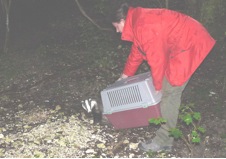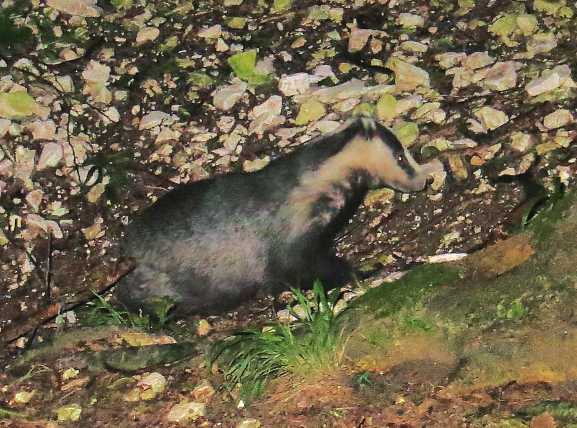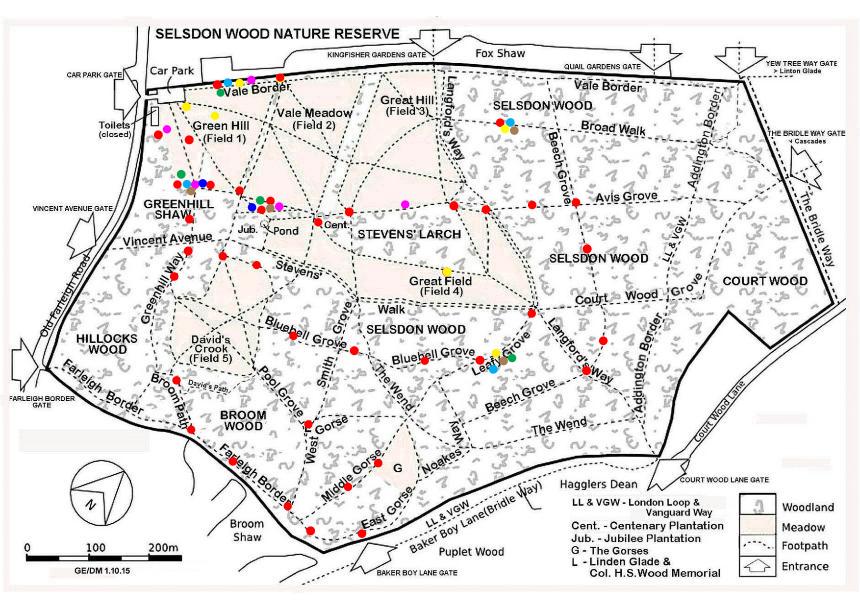
Galleries
Amphibians & Reptiles
---- Tadpole development - a series of photographs by Tony Flecchia ----
The frogspawn in the Jubilee pond (shown in the first photograph) never hatched in situ. By the time the little tadpoles were ready to emerge the spawn had collapsed and we assumed the stagnant water in the pond had killed it. Fortunately, we had removed a batch of spawn earlier to rear at home and the photos of the developing tadpoles below were taken from this. However, the high attrition rate was troubling and as deaths continued it appeared that the problem was virtually certain to be the ranavirus disease that has been killing frogs worldwide since about 1980. It also affects the developing tadpoles and the symptoms were all evident in these tadpoles, lethargy, loss of feeding, swollen abdomen and pigment changes. Apparently the water that infected frogs enter can become a home for the virus, reinfecting any later frogs and tadpoles, so there is not much hope for our still water pool. The disease also lethally infects all other amphibians and reptiles - which may explain why we have no other sightings. The froglet in the final photograph in the sequence was the only one remaining from the 80 tadpoles that we started with - and sadly it too died the following day.
Birds
An up-to-date listing of all the Birds seen in Selsdon Wood is provided on the Birds Sightings page.
The list will be updated when new species are seen - additions could occur at any time, particularly during migration.
Over the years we have installed many bird-boxes throughout the wood.
Crow Family - Corvidae
Finch Family - Fringillidae
---- Brambling (3) --- Chaffinch (2) --- Goldfinch --- Greenfinch --- Lesser Redpoll ---- Siskin (2) ----
Tit Family - Paridae
---- Blue Tit (4) ----Coal Tit ---- Great Tit ---- Long-tailed Tit ---- Marsh Tit ----
Thrush Family - Turdidae
---- Blackbird (5) ---- Mistle Thrush, Turdus viscivorus (2) ---- Redwing, Turdus iliacus (2) ----
---- Robin (4) ---- Song Thrush (4) ---
Birds of Prey - Hawks and Owls
--- Buzzard (2) --- Honey Buzzard --- Kestrel (2) --- Red Kite --- Sparrowhawk (2) ----
---- Tawny Owl (5) ----
Woodpeckers
---- Greater Spotted Woodpecker (10) ---- Green Woodpecker (3) ----
Also see this great story from David Malins about Woodpeckers nesting by his garden in 2015.
Other Birds
---- Blackcap (2) ---- Black Headed Gull ---- Chiffchaff (3) ---- Collared Dove (2) ---- Dunnock (2) ----
---- Firecrest ---- Goldcrest ---- Herring Gulls ---- House Sparrow ---- Mallard ----
---- Nuthatch (2) ---- Parakeet ----
---- Pigeon, Racing Homer (this is a distinct breed) ---- Pheasant (3) ----
---- Tree Sparrow ---- Starling ---- Stock Dove ---- Swallow ---- Swift ---- Treecreeper ----
---- Willow Warbler ---- Wood Pigeon (2) ---- Wren ----
Mammals
---- Badger (7) ----
July 2012 – Badger Rescue and Release – story & photograph from David Malins - In early July a young badger, about 6 months old, was injured by a car in Linton Glade. A concerned person called the RSPCA who collected the badger and took it to Wildlife Aid animal hospital in Leatherhead. The badger seemed to have suffered mild concussion and quickly recovered. Two days rest and good food confirmed it was ready to go home. The next job was to release the badger near a sett close to its accident.
I am a Committee member of the East Surrey Badger Protection Society, so was asked to assist the release. On a cold dark drizzly evening I met a representative from Wildlife Aid who brought the badger in a carrying cage. I decided that there were 2 setts that the badger could have come from - one in Selsdon Wood or another beyond Sorrel Bank. We took the cage and opened it on top of the largest sett which was in Selsdon Wood. The badger was reluctant to leave its comfortable cage – so it had to be gently tipped out. It lay on top of the sett for about 10 minutes trying to work out where it was. Then ignoring that sett, it set off hesitatingly along a badger path in a south-westerly direction towards other badger setts.
We were congratulating ourselves when it stopped and walked slowly in a wide circle. It then came out onto the main path, sniffed at our boots and then set off determinedly back along the main path in the opposite direction. It passed the sett I had chosen without hesitating and disappeared in the direction of the other sett I had considered. It appeared to know where it was going.
Young as it was it seemed to have a homing instinct, like pigeons, the badger was able to circle and then know the way home.
When wild animals are sick, injured or orphaned we rely on organisations like Wildlife Aid to give them a second chance.. Their programme of Rescue - Rehabilitate - Release needs our financial and practical help. Please see their website: www.wildlifeaid.org.uk and help them if you can.
14/6/12 – Badger - from Tony Flecchia - I'd resolved to get a photo of a badger in the wild for the FSW website. Targeting a known sett area, I first had to make sure they were in residence since they often move around in disturbed areas. So I went over on Wednesday evening (13/6/12) as it got dark and planted some peanuts in the four sett entrances that I thought were currently active. Returning first thing Thursday morning, the peanuts had gone so that showed they were in residence.
Thursday evening I set off to get there by just after 9pm knowing they'd be a late hours group in that location, but it started raining just as I left home. With everything set up and loaded with camera in silent mode, a camping stool and a torch for the return journey, I carried on anyway. Once there the protection from thin trees was poor and I had to be close for flash photos, so I chose a spot close to two holes, 6' and 8' away, set up the stool and sat down to wait in the wet. By 10.30pm it was completely dark under the trees so I would have to rely on hearing to know if a badger surfaced.
An hour and a quarter after getting there I heard a faint movement, raised the camera from under my sleeve and used the infra-red focus beam to see a badger just out of the 8' hole, but that scared it and it dashed back in. Several minutes later I sensed there was something there again though not hearing anything, so once again tried and this time the badger was there and it froze, trying to understand this bright red spot coming from my camera. I pressed the button and after what seemed an age the flash fired and I had the shot. Of course the flash scared the badger back down, so to avoid any more disturbance I left some more bonus peanuts and quickly left.
It was pouring by now and Broad Walk was pitch black under the low cloud cover and heavy rain, so it was a torchlit trip home through the woods. Broad Walk looks very different in darkness, seeming much narrower and closed in like a tunnel with only the odd moth flitting through the torch light despite the rain. I arrived home before 11.30 pm, bedraggled and very wet, but pleased to have got the photo.

|
white squirrel video.mp4 Size : 2608.956 Kb Type : mp4 |
Bats present particular challenges when it comes to researching and monitoring their presence in a given area. For many years it was believed that Selsdon Wood (SW) was home to Common Pipistrelles and nothing more. It was our attendance on bat walks at Wandle Park with Meike Weiser, Community Conservation Partnership Officer at Croydon Council, that piqued our interest in acquiring an Echo Meter Touch 2 bat detector for IOS, after seeing one in action in the hands of one of the attendees. It was a revelation - full spectrum detection and auto ID, it made the bat world immediately accessible.
With the hobbyist version in hand, we joined the FSW bat walk in July 2018. A visit to Leafy Grove revealed Common Pipistrelles and the group later moved into Great Field to walk back to the car park field. We hung back some 100 yards and as we traced the edge of Steven’s Larch the Echo Meter lit up and confirmed that the large bat that flew slowly over our heads and the group ahead was a Serotine.
This was the catalyst that indicated there may be more to discover in SW and during the subsequent months (until hibernation) we established (mainly in the corner of the car park, to the right of Greenhill Way as you look up the hill), that there were, at that point, four species present, either resident or visitors to the wood:
Common Pipistrelle, Serotine, Noctule, Leisler
In September, we had a recording the Echo Meter identified as a Bechstein’s bat, one of the UK’s rarest, with a population of only 1,500 residing mainly in the South. The recording was examined by Philip Briggs from the London Bat Group who advised that it could be either a Bechstein’s or a Natterer and in the final analysis felt it should be logged as the latter, so we ended 2018 with five listed species for SW plus recordings indicating the likely but at that point unconfirmed presence of Whiskered bats.
In 2019 the hobbyist version of the Echo Meter gave way to the ‘Pro’ version with a more sensitive microphone and extended tuning options. With this enhanced equipment the current year has seen recordings that increase the species list to nine.
Common Pipistrelle, Soprano Pipistrelle, Nathusius Pipistrelle (a guaranteed detection that has been independently verified by both Philip Briggs and John Russ, who are noted experts), Serotine, Noctule, Leisler, Natterer, Whiskered, Brown Long Eared.
The most exciting thing about the current position is we’ve edged closer to there being Bechstein’s present as a new recording on April 20 was garnered and forwarded to Philip Briggs for analysis. He responded: “It’s probably either Bechstein’s or Natterer’s bat but it’s trickier to be more precise than this as the call parameters are generally within the range for both species, with the end frequencies occasionally going a bit lower than Jon Russ’s book gives for Bechstein’s bat or a bit high for Natterer’s bat. I notice the calls are very clipped which could potentially reduce the reliability of measurements. Sorry I can’t be more conclusive, but it’s likely to be one or the other!”
Bats are a key indicator of the health of ecosystems. In order for bats to prosper, there needs to be plants and trees that support the requisite insect populations and so forth. That SW has nine species present, either resident or as visitors, is very welcome and we look forward to broadening and deepening the knowledge of these amazing and unique animals in the wood.
Steve Budd and Ruth Budd
The map below shows the locations at which bats of each species have been observed (as of 16/7/19).
The colour code is:

Other Mammals
---- Cat ---- Rabbit (2) ---- Rat ---- Common Shrew (2) ---- Pigmy Shrew ----
---- Squirrel, Grey (2) ---- Short-tailed Bank Vole ---- Weasel ----
---- Woodmouse ----
In February 2021 using the the BTO Acoustic Pipeline we found confirmation of 7 species, 5 of them new to SW records. These findings are tentative as the accuracy level of the classifier is unknown and as these were identified from ultrasound recordings there are no photographs. However, it will be interesting if we have any confirmation in future years.
Sundries
some other interesting signs of vertebrate life to be found in Selsdon Wood:
---- Gall Stone ---- Rabbit Droppings ---- Surrey Dragon ---- Solar Light ---- Squirrel's Drey ----
----- Woodpecker nest hole ---- Bruno! Fetch! ---- Kids Play Shelter ---- Nibbled Nuts ----
---- Hominid (bike riding) ---- Grave of Pet Rabbit ---- Burrow of Short Tailed Vole ----